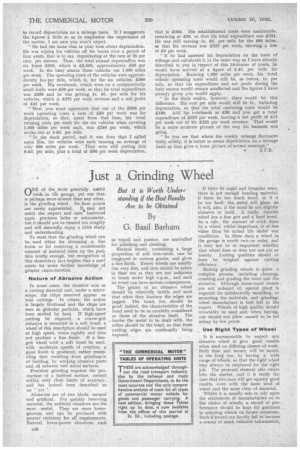Just a Grinding Wheel
Page 40

If you've noticed an error in this article please click here to report it so we can fix it.
But it is Worth Understanding if the Best Results .
Are to be Obtained
By G. Basil Barham
ONE of the most generally useful tools in the garage, yet one that • is perhaps more abused than any other, is the grinding wheel. Its finer points are rarely appreciated. Ito may not merit the respect and care bestowed .upon precision lathe or micrometer, but it should not be treated too roughly and will assuredly repay a little study and understanding.
To state that the grinding wheel can be used either for obtaining a fine iinish or for removing a considerable amount of material sums Up the posie tion briefly enough, but recognition of this elementary fact implies that a need exists for some further knowledge of grinder characteristics.
Nature of Abrasive Action
In some cases, the abrasive acts as a cutting material and, under a microscope, the chips removed appear as true cuttings. In others, the action is largely frictional and the chips 'are seen as globular particles, which have, been melted by heat. If high-speed cutting be required, a coarse-grit abiasive is mounted in a soft bond; a wheel of this description should be used at high speed, wears rapidly and does not produce a fine finish. If a finegrit wheel with a soft bond be used, with moderate speeds of rotation, a good finish is produced, rather resembling that resulting from grinding-in or bedding, by working abrasive paste and oil between tveo. metal surfaces.
Precision grinding requires the production of a finished surface, correct within very' close limits of accuracy, and has indeed been described as an " art."
Abrasives are of two kinds, natural and artificial. For quickly removing material, the artificial abrasives are the most useful. They are more homogeneous and can be produced with greater certainty for all requirements. Natural, lower-power abrasives, such as tripoli and pumice, are unriValled for polishing and cleaning.
Natural emery, containing a large proportion of soft iron-oxide, can be employed in various grades, and gives a fine finish. Emery wheels are usually run very fast, and care should be taken in their use as they are not unknown to break under high r.p.m., and such an event can have serious consequences.
The grains of an abrasive wheel should be relatively brittle and such that when they fracture the edges are jagged. The bond, too, should be good: indeed, the characteristics of the bond need to be as carefully considered as those of the abrasive itself. The, -'harder the metal to be dealt with, the stifter should he the bond, so that fresh cutting edges are continually being exposed.
If there be rapid and irregular wear, there is not enough bonding material; if there be too Much bond, or if it be too hard, the, metal will glaze, as it 'will, also, if the bond be not slightly abrasive in itself. A really durable wheel has a fine grit and a hard bond. As a rule, the amount of work One by a wheel, whilst important, is of less value than -its actiial life under war conditions. In these days a wheel in the garage is worth two on order, and it may not be so important whether that wheel does or does not not cut so keenly. Lasting qualities should at least be, weighed against ctittiisg
efficiency. \ Making grinding wheels is quite a complex process, including cleaning, crushing and grading the bond and the abrasive. Although home-made wheels are not unheard of, special plant is required for satisfactorily moulding, or mounting the, materials, and grinding-. wheel manufacture is best left to the expert. Wheels of high quality 'should invariably be used and, when buying, one 'should not 'allow oneself to be led astray by low prices.
Use Right Types of Wheel It is unreasonable to expect any abrasive wheel to give good_ results when used on differing classes of work. Both time and money will be saved, in the long run, by having a wide range of wheels, so that the right wheel may always be employed for the right job. The personal element also enters into the matter, and it is rarely the case that two men will get equally good results, even with the iame kind of wheel and the same class of material.
Whilst it is usually safe to, rely upon the statements of manufacturers as to the choice of wheels, a record of performance should be kept for guidance in selecting wheels on future occasions. Such i record can hardly .fail to become a source of much valuable information,




























































